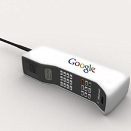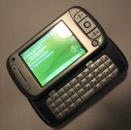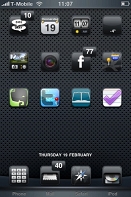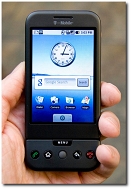Erstellt am: 19. 2. 2009 - 12:46 Uhr
State of the (mobile)Nation
Last week I had the good fortune to play around with one of the latest entries on the Smartphone market. T-Mobile's G1, a.k.a. the HTC Dream, a.k.a. the Google Phone.

http://www.interactivecleveland.com
It was an interesting experience, especially in combination with a forced foray into smartphone history. An unexpected iPhone suicide had left me back in the hands of my ancient companion, the HTC Hermes. A Windows Mobile 5 phone that had been extensively modified (to WM6) in order to make it do the things I wanted it to do.
Not crash for example.
After a year and a half of the iPhone, my expectations of a mobile communication device had changed just a bit. As a freelancer, I'm not tethered to some corporate exchange account. As a matter of fact, Im not just not tethered, I don't really have any decent remote access to the one exchange account I need to worry about. This means that the biggest bonus Windows Mobile had to offer, it's potential for integration into a corporate IT setup, was less than useless. It was irrelevant.
What I needed was a way to be connected to the web. Not some ghettoized version of wap sites and minimalist mobile offerings designed not to choke Pocket Internet Explorer. I needed access to the whole damn thing. Or at least as much of it as possible.
Aside from that, I needed decent speed, reliability, and one handed access. And I needed everything to be completely wireless. Over The Air Syncing is a must.
Inside of three weeks I had pretty much run the gamut of mobile computing options. Played around with portable versions of Linux, Windows and OSX, and experienced a wide range of user interface designs, hardware policies and software strategies.
Each platform had it's own weaknesses that needed to be addressed by modifying the software that was delivered with the device. Something that may be increasingly difficult to do, if the hardware producers and service providers have their way.
The Ancient Past: WinCE

Public Domain
In the case of Windows Mobile, the biggest problem was the system software itself. Windows Mobile 5 and earlier provided no easy way to make updates to the system. So if your phone had a buggy bluetooth driver, or a telephone radio software that crashed, you had to wait for your telephone operator to get around to releasing a firmware update that MIGHT fix the bug. In the case of the TyTn that I had, that meant that the stereo bluetooth it was advertised with didn't work, and the telephone part of the software would crash without notice. In other words, my phone would be on and look like it was working, it just wouldn't be connected to the telephone network.
That was the situation quite a few people found themselves in a few years ago. A situation that led to a site dedicated to the fixing of Windows Mobile phones, the development of improved software, and the creation of firmware images that actually worked. IF you managed to install them without destroying your device.
Microsoft took a pretty dim view of this service. Well, they took a dim view of people repackaging and distributing versions of their mobile operating system. You see, there really was no way for end users to get a hold of system updates legally, if their provider wasn't willing to provide them.
Well, that's not entirely true. There was one way. You could buy the latest phone. That phone would have the fixed drivers that would have been needed to do the things you thought you were going to be able to do with your old phone. Of course, it would also come with it's own set of bugs...
Microsoft eventually convinced XDA-Developers to stop hosting firmware files. And by convinced I mean threatened them with legal action. It' still one of the best sites out there for people who want to actually get something done with their Windows Mobile phones though.
The Recent Past: myPhone?

David Dempsey
The iPhone on the other hand, came with a nifty way for the system to be upgraded, the phone developer itself took responsibillity for the updates, and they actually delivered updates that managed to improve the phone each and every time.
In other words, they over-sold and under-delivered. A situation that soon had hordes of iPhone fans out there finding ways to find solutions to the problems Apple had decided to leave unsolved. While Windows Mobile devices would have cutting edge hardware with lackluster or faulty drivers, but loads of software waiting to use it, the iPhone came out with fairly solid divers that only barely scratched what the hardware was actually capable of.
It also didn't come with software that might mess with its partners business model. iChat? That would have hurt the sms business. Want to use the phone as a mobile modem? That would mean you might actually be able to consume the abound of bandwidth you had been sold.
The iPhone would do what it was supposed to do, but if you wanted it to do what it was capable of doing, you would have to get in there and mess it up. Which is what Erica Sadun and Geohot and loads of other people did. They gave us the tools that could help the iPhone live up to its potential (and its Hype).
It's also something Apple has finally taken an Official stand on. They think it's illegal.
And now we have the Google Phone.

© MobileBurn
Like desktop linux, the G1's version of linux seems intent on combining the mistakes made by Apple and Microsoft.
The G1's software seemed stable enough. It looks like a Windows Mobile device (not surprising considering it was produced by HTC) and under-delivers like the iPhone. Want to do something fun with blue tooth? Use your Stereo headphones perhaps? Well, you will just have to wait.
One of the most bizarre things about the phone was it's lack of a soft keyboard. It makes one handed text entry completely impossible. User interface? I didn't get to spend a lot of time with it, but trying to find my way around the settings was a bit of a pain, and in one of the most exciting apps (a location aware to-do list) I could not for the life of me figure out how to define a location.
A few of those things will probably be addressed in the next firmware update. The impatient (like me) could hack it, but that sounds like a Very Bad Idea. Most people should just wait. The update should be available to anyone. Eventually. I just wish I would have had access to the phone long enough to find out. Of course, I guess that's what things like mobileblogger.at is for.
So where does that leave us?
Mobile computing and smart phones have made some major advancements. Not just in the quality of software and hardware offerings, but in the expectations and concepts of what we could do on the go. I am looking forward to a mad rush of new developments, and maybe, someday soon, a true iPhone killer that will give mobile computing the critical mass needed to get some truly exciting applications out there.
I also learned that for now, no matter which device you decide on, they all need to be hacked.


